9 Legendary Ski Resorts in France
France has some of the highest and snow-sure ski resorts in Europe. Many sit above 1,800 meters, with long seasons stretching from late November to April or even May.
You’ll find modern lift systems, large linked ski areas, and a mix of slopes for all levels. Some are purpose-built with ski-in ski-out access, while others are old alpine villages with more charm.
Off-piste options and glacier skiing are common, along with lively après-ski scenes in the bigger spots.
Whether you’re after high-altitude snow, legendary off-piste runs, or a resort with a buzzing après-ski scene, here are the top ski destinations in France.
1. Chamonix-Mont-Blanc (Haute-Savoie)
Sitting at the foot of Mont Blanc, Chamonix is one of the world’s most famous alpine destinations, attracting serious skiers, mountaineers, and adventure seekers.
This is where you go for steep, high-altitude terrain, legendary off-piste routes, and a no-nonsense mountain atmosphere.
Unlike most ski resorts, Chamonix isn’t a single ski area but a collection of separate domains. Grands Montets is the place for deep powder and long, technical descents. Brévent-Flégère offers south-facing slopes with stunning views.
Le Tour is great for intermediate skiers, while Les Houches provides scenic tree runs that stay sheltered in bad weather.
The real icon of Chamonix is the Vallée Blanche, a 20 km off-piste route from the Aiguille du Midi that takes skiers through a high-alpine glacier landscape. It’s a bucket-list run, but only for those with a guide and the right avalanche gear.
Chamonix itself is a real town with a buzzing year-round population and an international crowd. Après-ski leans more towards craft beer bars and mountaineering hangouts than wild parties.
Elevation 1904 is a favorite for its central location and lively atmosphere, while MBC (Micro Brasserie de Chamonix) serves up excellent locally brewed beers.
2. Courchevel (Savoie)
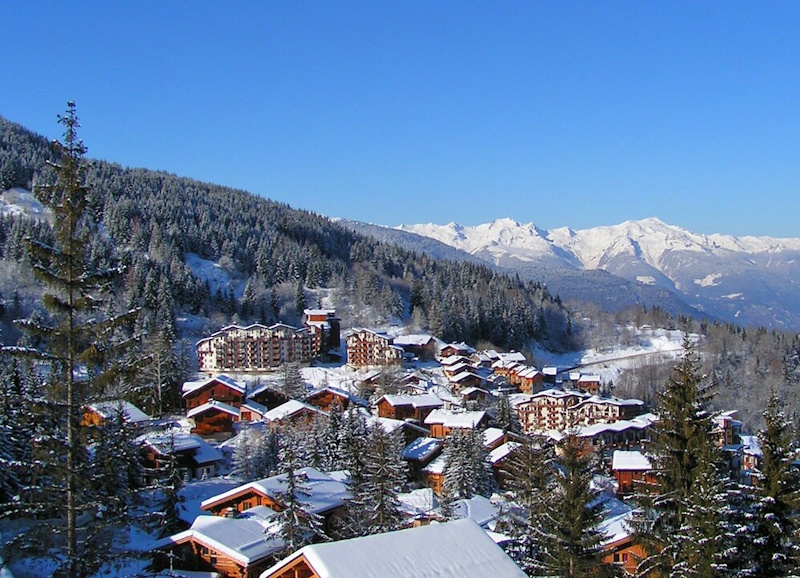
Courchevel is the luxury capital of the Alps, combining world-class skiing and a high-end vibe. Beyond the terrain, what sets Courchevel apart is the exclusivity, service, and refinement.
The resort is part of Les Trois Vallées, the largest ski area on the planet, with 600 km of slopes and a seamless lift network that keeps you moving without delays.
The resort is split into different levels, each offering a distinct vibe. Courchevel 1850 is the ultra-luxurious heart of the resort, home to five-star hotels, Michelin-starred restaurants, and designer boutiques. It attracts a wealthy international crowd looking for top-tier service and effortless ski-in/ski-out access.
Courchevel 1650 (Moriond) has a more relaxed, family-friendly atmosphere, while Courchevel 1550 and 1300 (Le Praz) offer a quieter, more authentic alpine experience with traditional chalets and fewer crowds.
The skiing is outstanding, with perfectly groomed pistes, scenic tree runs, and easy access to the rest of Les Trois Vallées.
The Combe de la Saulire is one of the best red runs in the Alps, while the steeper Grand Couloir challenges even expert skiers. Snow reliability is excellent, thanks to Courchevel’s north-facing slopes and extensive snowmaking.
Après-ski leans more towards chic lounges and high-end dining than wild parties. Le Tremplin offers lively drinks at the base of the slopes, while Les Caves is the place for late-night champagne-fueled revelry.
3. Val Thorens (Savoie)

Val Thorens is all about altitude and snow reliability. Sitting at 2,300m, it’s the highest ski resort in Europe, which means it gets some of the best and most consistent snow in the Alps.
The season runs from November to May which makes it a go-to destination for early and late-season skiing when lower resorts struggle with coverage.
As part of Les Trois Vallées, it has direct access to 600 km of slopes, the largest ski area in the world. Unlike some linked resorts, every lift in Val Thorens connects efficiently, so you’re never wasting time getting from one side of the valley to the other.
The terrain is incredibly varied, with high-speed carving pistes, wide-open powder fields, and technical descents for advanced skiers.
The resort itself is modern and purpose-built, meaning most accommodations are ski-in/ski-out.
While it lacks the old-world charm of lower-altitude resorts, it makes up for it with one of the liveliest après-ski scenes in the Alps. Bar 360 is the go-to for outdoor DJ sets on the slopes, while Le Saloon keeps the party going late into the night.
4. Val d’Isère (Savoie)
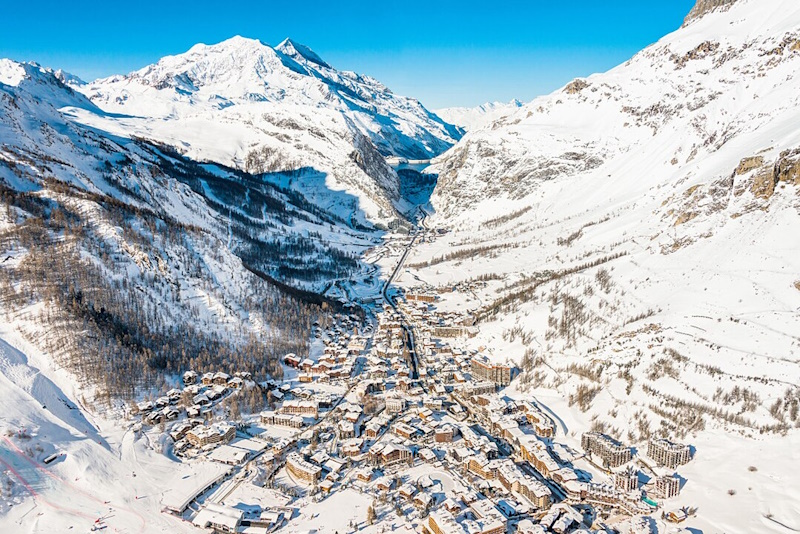
Val d’Isère is the epicenter of elite skiing in France, allying world-class terrain with a historic alpine village atmosphere. It shares the Espace Killy ski area with Tignes with 300 km of pistes.
But what makes Val d’Isère stand out is its steep, challenging slopes and rich ski heritage. It has hosted multiple World Cup races, and its Face de Bellevarde black run, built for the 1992 Olympics, is one of the most demanding in the Alps.
Unlike many high-altitude resorts, Val d’Isère has a proper mountain village feel, with traditional stone buildings, boutique shops, and a lively, year-round population.
It’s an excellent choice for expert skiers, with some of the best off-piste terrain in the world, including the legendary Le Fornet sector, known for its deep powder and quiet, untouched slopes.
For a more relaxed ski experience, the Solaise area offers wide, forgiving runs and stunning views, ideal for intermediates and families. The resort has one of the most efficient lift networks in the Alps, meaning fewer queues and more time on the snow.
Après-ski in Val d’Isère is legendary, but without the over-the-top party vibe of some other resorts. Le Petit Danois is a great spot for affordable drinks and a fun crowd, while Le Blizzard offers a more refined, fireside cocktail experience. Doudoune Club is the place for DJs and dancing until sunrise.
5. Tignes (Savoie)
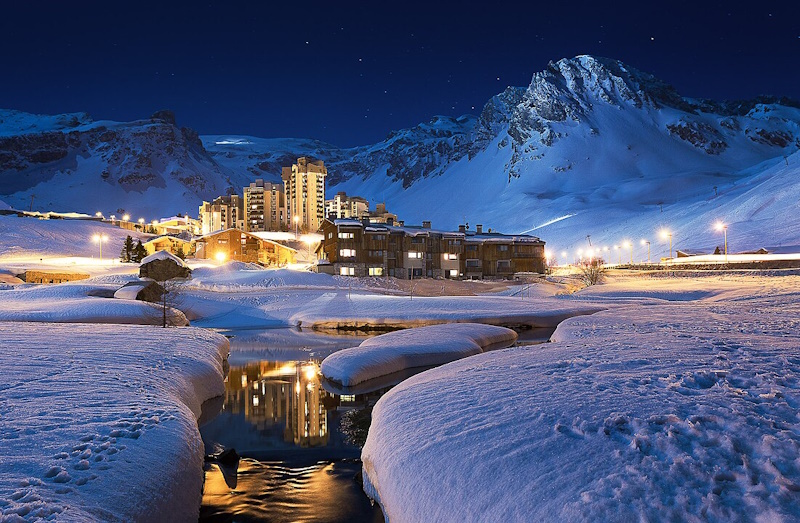
Tignes is all about high-altitude snow-sure skiing with a no-frills, sport-focused atmosphere. At 2,100m, it’s one of the most reliable resorts for snow in the Alps, with the Grande Motte Glacier allowing skiing from October to May.
While some resorts worry about snow coverage, Tignes delivers deep powder and well-maintained pistes long before and after the standard season. The ski area is shared with Val d’Isère, forming the Espace Killy, which offers 300 km of varied terrain.
Tignes is ideal for those who love big, open slopes, fast lifts, and wide, confidence-boosting runs. Advanced skiers can test themselves on La Sache, a long, technical black run descending 1,200m into Les Brévières, or explore the endless off-piste bowls and couloirs.
The resort is built for convenience rather than charm, with modern ski-in/ski-out accommodations spread across multiple villages. Tignes Le Lac and Val Claret are the most popular hubs, while Les Brévières has a quieter, more traditional feel.
Après-ski is fun but more casual compared to other major resorts. Loop Bar is the best spot for post-ski drinks with live music, while Cocorico gets lively in the afternoons.
Tignes also offers ice diving, bungee skiing, and an indoor sports complex with a pool and climbing wall.
6. Méribel (Savoie)
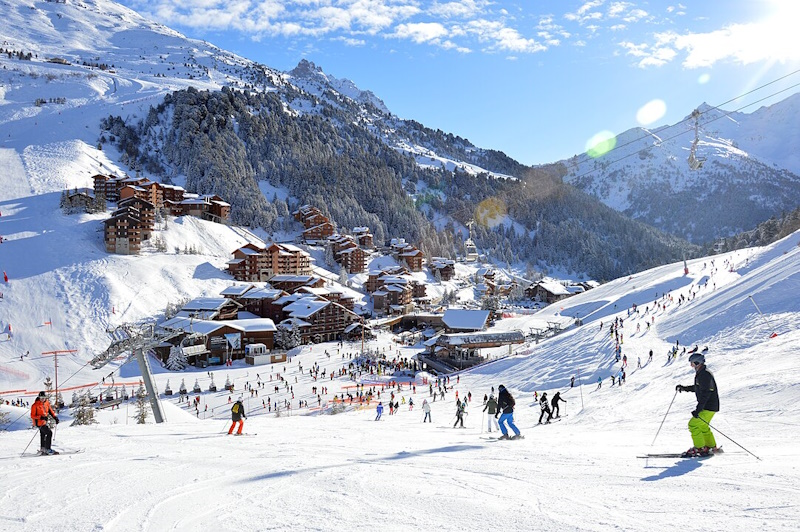
Méribel is the heart of Les Trois Vallées, perfectly positioned to give skiers easy access to both Courchevel and Val Thorens.
Unlike many purpose-built resorts, Méribel has maintained a traditional alpine charm, with chalet-style buildings instead of concrete high-rises. This gives it a warm, welcoming feel that appeals to families and groups seeking a balance of great skiing and a lively atmosphere.
The terrain suits all abilities, with long, rolling pistes perfect for intermediate skiers and a well-developed lift system that makes it easy to cover huge distances in a single day.
For advanced skiers, the Mont Vallon area offers steep, high-altitude descents with incredible views. There’s excellent off-piste in the Lac du Lou valley.
Méribel also stands out for its English-speaking community which makes it a favorite among British skiers. The après-ski scene is lively but not overwhelming.
Rond-Point (The Ronnie) is the go-to for slope-side beers and live music, while Le Pub in the center of town keeps the energy going after dark.
7. Megève (Haute-Savoie)
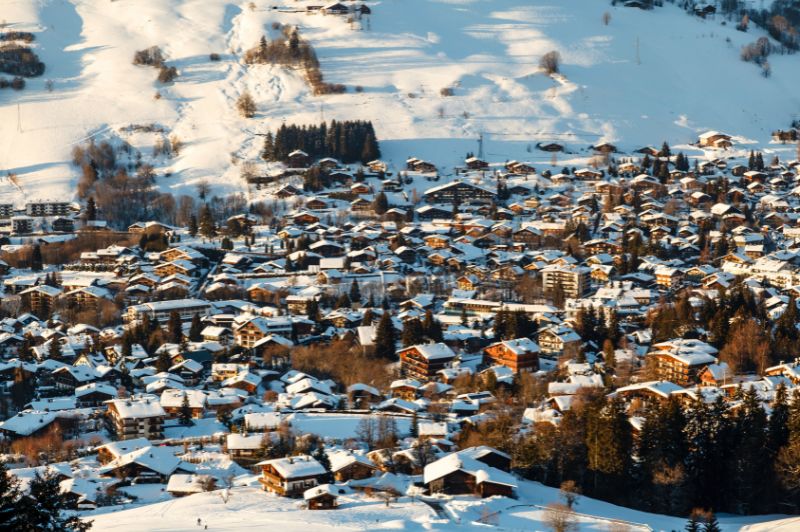
Built in the 1920s as France’s answer to St. Moritz, Megève still holds onto its old-world elegance, with cobblestone streets, horse-drawn carriages, and a village square that feels straight out of a postcard.
Unlike many high-altitude resorts, Megève has a proper town atmosphere, lined with independent boutiques, gourmet restaurants, and comfy cafés where locals sip vin chaud by the fire.
The skiing spans 400 km of scenic, tree-lined runs, shared with Saint-Gervais. While it doesn’t have the extreme terrain of some other resorts, its gentle slopes and beautifully groomed pistes offer great comfort.
Powder hunters, however, head to Mont Joly, where the steeper north-facing slopes hold onto fresh snow longer than anywhere else in the area.
Megève is also a food lover’s paradise. It has more Michelin-starred restaurants than any other ski resort in France, including three-star Flocons de Sel which serves some of the best fine dining in the Alps.
Après-ski is more refined than rowdy, with chic wine bars and piano lounges, though Le Wake Up offers a late-night party for those who want one.
8. Alpe d’Huez (Isère)
Alpe d’Huez is all about long, uninterrupted skiing and endless sunshine. It boasts the longest black run in Europe, the 16 km Sarenne which takes skiers from the glacier down to the valley in a single, breathtaking descent.
The resort sits on a high plateau, meaning it gets more than 300 days of sunshine per year – one of the best places for bluebird skiing.
The ski area is vast, with wide, rolling pistes that suit all abilities, but experts will find some of the best steep, ungroomed terrain in the Alps in the couloirs and bowls above the village. The lift system is also excellent, which cuts down on wait times even in peak season.
Après-ski kicks off at Smithy’s Tavern, a longtime favorite for its lively crowd and live music. Alpe d’Huez has night skiing, letting you carve down floodlit runs long after the sun sets.
If you need a break from skiing, the resort also offers an indoor sports complex, an outdoor heated swimming pool, and an ice rink.
9. Avoriaz (Haute-Savoie)
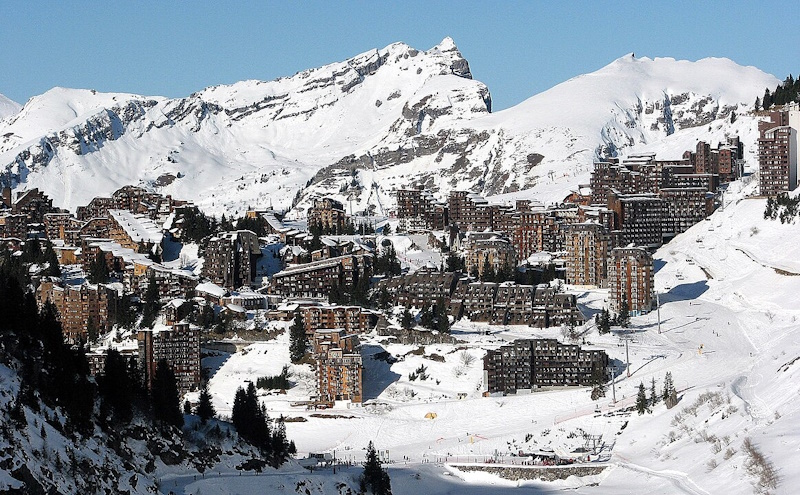
Avoriaz is the ultimate ski-in/ski-out resort. Every single accommodation has direct access to the slopes, so there’s no hauling gear through town or waiting for a shuttle.
The village itself is car-free, with horse-drawn sleighs and wooden architecture giving it a unique, almost otherworldly feel.
Freestylers head straight to The Stash, a one-of-a-kind snowpark built in the trees with natural wooden features.
Families love the Aquariaz water park, a tropical-themed indoor complex with slides, waterfalls, and warm pools—perfect for a break from the cold.
Portes du Soleil, the ski area Avoriaz belongs to, stretches across France and Switzerland with 650 km of slopes. That means you can ski over the border for lunch and come back in time for après at La Folie Douce, which turns into a full-on mountain club by the afternoon.
10. Les Deux Alpes (Isère)
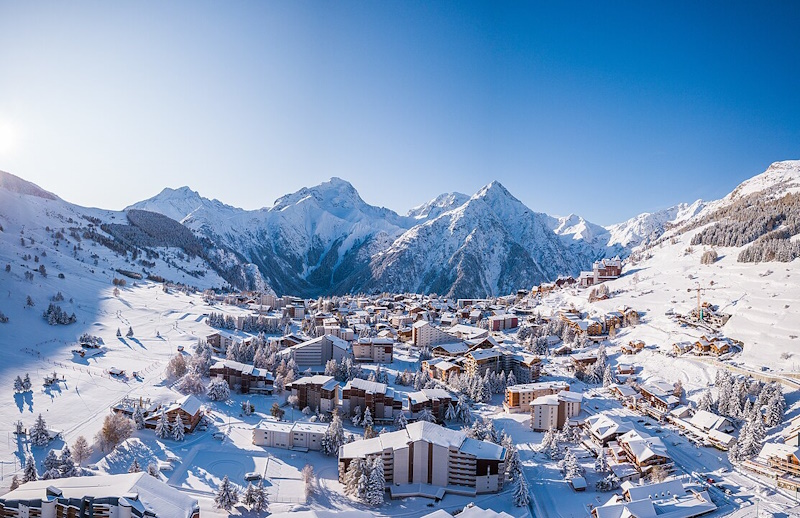
Les Deux Alpes is a paradise for skiers who want guaranteed snow and serious vertical. It has one of Europe’s highest skiable glaciers, meaning conditions stay reliable even when lower-altitude resorts struggle.
Unlike most ski areas, the layout is flipped: beginner slopes are at the top, while the steepest runs descend back to the village, which is great for mixed-ability groups.
Freestyle skiers and snowboarders come for one of Europe’s best snowparks, packed with huge kickers, rails, and halfpipes. Those who crave adventure can take a guide to La Grave, an unmarked off-piste zone with legendary descents through untouched powder.
Après-ski is high-energy, with Pano Bar turning the slopes into an afternoon dance floor. Later, L’Avalanche keeps the party going late into the night, and The Polar Bear Pub is a more relaxed spot for craft beers and a post-ski debrief.
11. Morzine (Haute-Savoie)
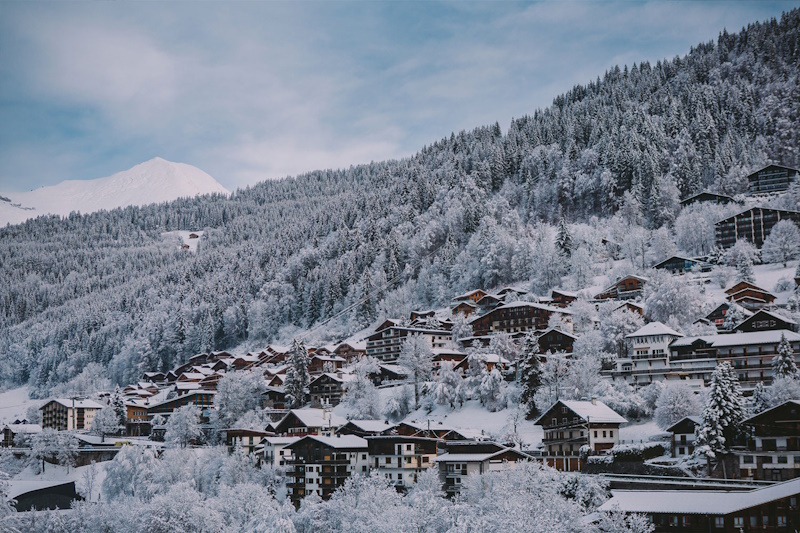
Morzine is for skiers who want a real alpine town with year-round life. Unlike purpose-built ski stations, Morzine has an authentic French atmosphere with bakeries, family-run restaurants, and a weekly market selling local cheeses and charcuterie.
Its location in Portes du Soleil gives access to 600 km of slopes. But what makes Morzine stand out is its versatility. Beginners and families get gentle runs and top-tier ski schools, while advanced skiers can take the lift to Avoriaz for steep terrain and powder-filled freeride zones.
Off the slopes, Morzine has a strong seasonnaire scene, which means bars stay lively well into the night. Bar Robinson is famous for its dangerously strong Mützig beer, while The Cavern keeps the party going with DJs and live music.
There are also scenic snowshoe trails and an indoor ice rink hosting pro hockey games.
12. La Plagne (Savoie)

La Plagne is the ultimate resort for families and intermediate skiers looking for a stress-free ski holiday. It’s part of Paradiski, linked with Les Arcs to offer 425 km of slopes.
La Plagne stands out for its vast network of gentle, wide pistes that make skiing there incredibly accessible. With mostly blue and red runs, it’s perfect for skiers who love long, scenic descents without worrying about extreme terrain.
The resort is made up of multiple villages, each offering a different experience. Plagne Centre and Belle Plagne are the busiest hubs, packed with restaurants and easy ski-in/ski-out accommodations.
Plagne 1800 and Montchavin-Les Coches have a more traditional chalet atmosphere, while Plagne Soleil and Plagne Villages are quieter, great for doorstep skiing without the crowds.
For adventure seekers, La Plagne is home to one of the only Olympic bobsleigh tracks in Europe. Visitors can ride a real competition-style sled, hitting speeds of over 100 km/h for an adrenaline rush you won’t find at most ski resorts.
Off-piste skiers can also explore the steep north-facing terrain above Bellecôte – some of the best freeride opportunities in the area.
Après-ski here is more relaxed compared to party-heavy resorts, but Igloo Igloo offers a fun atmosphere in an ice-themed bar, and La Mine provides live music in a cozy, underground setting.
13. Les Arcs (Savoie)
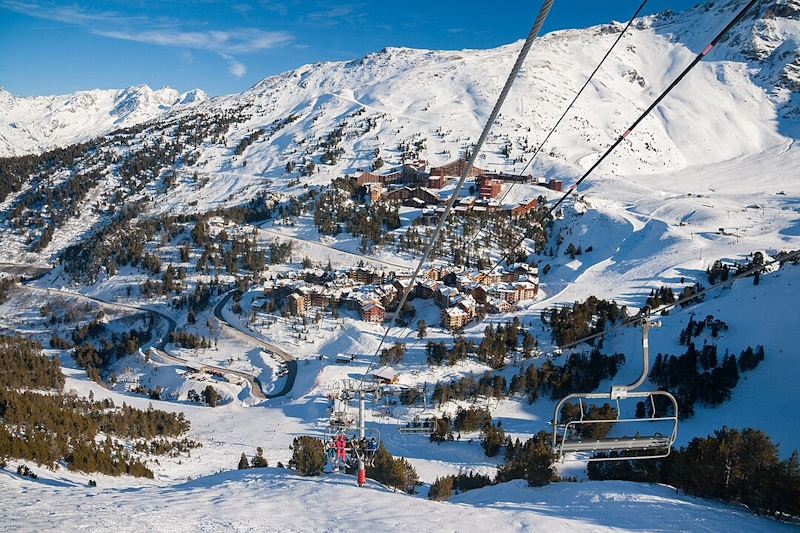
Les Arcs is all about efficiency, variety, and high-altitude skiing without the crowds.
Spread across four main villages – Arc 1600, 1800, 1950, and 2000 – it offers direct access to the Paradiski area, with 425 km of slopes linked to neighboring La Plagne via the Vanoise Express cable car.
The skiing is diverse, with everything from tree-lined runs to high-alpine bowls, which makes it a great choice for mixed-ability groups.
Les Arcs is paradise for intermediates with long, well-groomed red and blue runs that let you rack up serious mileage.
Advanced skiers head to Aiguille Rouge, the resort’s highest peak at 3,226m, to tackle a 7 km descent with a 2,000m vertical drop, one of the longest continuous runs in the Alps.
The resort is also a top spot for off-piste, with accessible freeride zones that stay untouched for days after a snowfall.
Les Arcs is designed for convenience, with modern, ski-in/ski-out accommodations in every village. Arc 1950 is the most charming, with a pedestrian-only center and more traditional architecture, while Arc 1800 is the liveliest, packed with bars and restaurants.
Après-ski is more laid-back compared to party-heavy resorts, but Red Hot Saloon in Arc 1800 is the go-to for drinks and live music. Les Belles Pintes in Arc 1950 has a more relaxed, pub-style atmosphere.
14. Serre Chevalier (Hautes-Alpes)
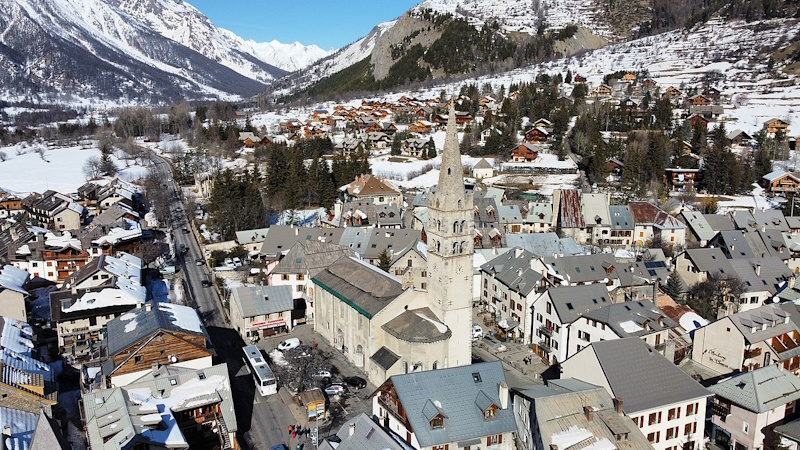
Serre Chevalier is the go-to resort for skiers who want big terrain without big crowds. With 250 km of slopes, it’s one of the largest ski areas in the southern Alps, yet it remains refreshingly uncrowded, even in peak season.
The ski domain connects several villages, each with a distinct character, from the historic charm of Briançon to the more modern base at Villeneuve.
What makes Serre Chevalier special is its incredible tree skiing. Unlike many high-altitude resorts, it has vast forests covering the lower slopes, which creates awesome conditions for powder days when visibility is poor.
The off-piste terrain is some of the best in France, with long, open bowls and hidden gullies that hold fresh snow for days after a storm.
Away from the slopes, Serre Chevalier has something unique: natural thermal baths in Monêtier-les-Bains, where skiers can soak in steaming hot water after a long day on the mountain.
Après-ski is more relaxed than rowdy, but La Grotte in Villeneuve is the spot for live music and late-night drinks. Overall, it’s a great resort with a laid-back vibe, big mountain skiing, and fewer lift queues.
